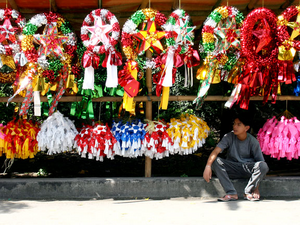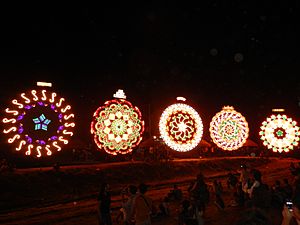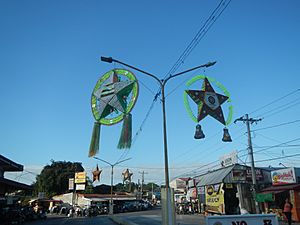Parol facts for kids
A parol is a special Filipino lantern. It is a beautiful decoration shown during the Christmas season. The word "parol" comes from the Spanish word farol, which means "lantern."
Traditionally, parols are made from bamboo and a type of Japanese paper. They were lit with candles or oil lamps. Today, parols can be made from many materials like plastic, metal, and capiz shells. They usually light up with electric bulbs. The most common shape is a five-pointed star. But they can also be found in many other shapes and sizes. Very large, round electronic parols from Pampanga are called "parul sampernandu." This name comes from San Fernando, Pampanga, the city famous for making these lanterns.
The parol is an important part of the Panunulúyan, a special Christmas play in the Philippines. This play is part of the nine-day Christmas Novena procession. During the Spanish colonial period, parols were first rectangular or oblong. They were made with white paper. Over time, they changed into different shapes and colors. During the American colonial period, the five-pointed star became the standard shape. This star represents the Star of Bethlehem. The parol is still a very important symbol of Filipino Christmas.
Contents
History of the Parol Lantern

The word paról is the modern Filipino way to spell the Spanish word farol, which means "lantern." In local languages, parols and other lanterns are also called paritaan.
The tradition of the parol began during the Spanish colonial period in the Philippines. It came from the Spanish custom of carrying small lights. People used torches, candles, or braziers during the nine-day Christmas Novena procession. This procession leads up to the midnight mass, known as Simbang Gabi in the Philippines. Parols are used only for the Christmas Novena procession. For other Novena processions, people carry lit candles.

Parols are especially connected to the Panunulúyan play. This play is a reenactment of Joseph and the pregnant Virgin Mary searching for a place to stay in Bethlehem. The actors playing Joseph and Mary, along with the townspeople, carried paper lanterns. These lanterns were made with bamboo and Japanese paper. After the procession, people hung these lanterns outside their homes as decorations. Over time, they became a key part of Filipino Christmas tradition. Even José Rizal, a national hero, mentioned the importance of parols in 1893. He asked his family to send him Japanese paper so he could "celebrate Christmas properly."
Early parols during the Spanish era were simple. They were usually rectangular or oblong and made with white paper. They were lit by candles or coconut oil lamps. By the 1830s, their shapes and colors became more varied. Some had complex designs made by folding paper. Each lantern was made by hand, so designs were different from house to house.
The paról did not get its standard five-pointed star shape until the American colonial period. People say that an artisan from Pampanga named Francisco Estanislao made the first five-pointed star-shaped parol in 1908. He made it from bamboo strips covered with Japanese paper. It was lit by a candle or a carbide lamp.
The first battery-operated parols with incandescent bulbs were made in the 1940s. In 1957, a lantern-maker named Rodolfo David invented parols with rotating systems. His parol was used by Barangay Santa Lucia in the Giant Lantern Festival of San Fernando, Pampanga. They won the festival from 1957 to 1959. His parol used spinning steel drums with wires to control the lights and music. This design became the basis for electric parols called Parul Sampernandu, sold from 1964 onwards.
How Parols are Made and Designed
Traditionally, parols have a frame made of bamboo sticks. These sticks are then covered with colorful pieces of Japanese paper or crêpe paper. The most common design is a five-pointed star with two decorative "tails."
Today, parols can be made from many different materials. These include plastic, shells, glass, beads, foil, feathers, hemp, leaves, seeds, plastic straws, wood, and even metal. They come in various sizes. Some are small, made of tinsel and foil. Others are giant lanterns lit by electricity at night. They might have one, three, or more tails, not just the usual two. Some have a "halo" around them. The number of points on the star usually ranges from four to about ten, but some have even more. More complex star shapes can look like a rose, a bromeliad (like a pineapple), a snowflake, or a sea urchin.
Other designs, besides the star, include angels, huge flowers, Santa Claus's face, reindeer, happy faces, and Christmas trees. These often use Western holiday symbols.
Lantern-makers in Pampanga have their own long tradition of parol design. The Kapampangan parol has four layers. The center circle is called the tambor or tambur ("drum"). The next layer is the siku-siku ("elbow"), which has criss-crossing star shapes. The third layer is the palimbun, a circle that surrounds the siku-siku. The last layer is the puntetas ("edges" or "tips"), which have smaller, detailed designs. Pampanga is also where the first electric and battery-operated parols with automatic rotating systems came from. These were made from the 1940s to the 1960s.
Recently, new ideas from Pampanga include lanterns with electronic lights. These lights can be programmed to create a dancing effect. People also use LED rope lights, known as "flexilight" lanterns.
The original star design of the parol is still very common in the Philippines. It is seen as unique to Filipinos. Making traditional lanterns is often taught to schoolchildren around Christmastime. However, most parols are now made in specific towns and villages, not so much in big cities. San Fernando, Pampanga, is known as the "Home of the Giant Lanterns." It has a huge lantern-making business. Las Piñas, a city in Metro Manila, also produces many parols.
How Parols are Used
In the Philippines
In the Philippines, the parol has become a famous symbol of Filipino Christmas. It is as important to Filipinos as the Christmas tree is to Western cultures. Parols usually start appearing on houses and streets in September, along with other Christmas decorations. This signals that the Christmas season is coming. The parol is also still connected to the Simbang Gabi tradition. This is a series of dawn masses that lasts for nine days. These lanterns stay up until January, usually taken down after Epiphany. This honors the Three Kings and their visit to baby Jesus.
Many communities, like villages, schools, and groups, hold contests to see who can make the best parol. One famous event is the annual Giant Lantern Festival in Pampanga. This festival brings together many skilled lantern-makers from all over the country. The competition is about how well giant parol light up and perform. These lanterns can be as wide as 40 feet (12 m). They are programmed to "dance" to music played by a brass band.
Overseas
Filipinos living in other countries have also started using the parol as a Christmas decoration. In Austria, the lanterns are a big attraction at the annual Wiener Christkindlmarkt (Vienna Christmas Market). Sixty parols were lit on a 'Philippine Tree' at the Wiener Rathausplatz. This project was a team effort between the city government and the Philippine Embassy in Vienna. They introduced the lanterns in 2006.
Since 2005, a famous artist named Fred Deasis offers free Parol Making Workshops. These workshops are for the Filipino community in the Chicago, Illinois area and nearby states. Public libraries, churches, and Filipino-American cultural groups help organize these workshops. During the workshop, people learn to make a traditional Filipino Christmas parol. It is designed by the artist and uses only 5 bamboo sticks, Japanese paper, rubber bands, wire, glue, and ornaments.
In San Francisco and Los Angeles, California, Filipino Americans celebrate an annual Parol Festival in December. Parols are also common Christmas decorations for Filipino-American homes and churches. Filipinos in Canada hang parols in their party halls during Christmas parties. This helps them remember their traditional use of the lantern.
See also
- Belén, another traditional Filipino symbol of Christmas
- Luminaria
- Windowpane oyster
- Las Posadas, a similar Novena tradition in Latin America
- Piñata, a similar but separate tradition in Mexico symbolizing the Star of Bethlehem
- Christmas lights





